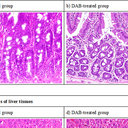Multiple point action mechanism of valproic acid-teratogenicity alleviated by folic acid, vitamin C, and N-acetylcysteine in chicken embryo model.
Słowa kluczowe
Abstrakcyjny
The teratogenicity of antiepilepsy drug valproic acid (VPA) mostly is found in genetic and somatic levels, causing teratogenesis involving neurotubular defects (NTDs), anencephaly, lumbosacral meningomyelocele, and leg dysfunction due to spina bifida aperta. A diversity of nutraceutics have been tried to alleviate the risk of VPA-teratogenicity. The effect was varying. In order to promote the preventive prescription, to find out its action mechanism can be rather crucial. We used chicken embryo model to try the effect of folic acid (FA), ascorbic acid (AA), and N-acetyl cysteine (NAC). VPA at 30mM showed the higher malformation rate (66.7%) with the least mortality (22.2%). Pathological findings indicated that the cervical muscle was more susceptible to VPA injury than the ankle muscle. VPA downregulated levels of superoxide dismutase (SOD), glutathione (GSH), histone deacetylase (HDAC) and folate, and upregulated H(2)O(2) and homocysteine. FA, AA, and NAC significantly upregulated SOD, but only AA alone activated GSH. AA and NAC downregulated H(2)O(2), while FA was totally ineffective. All three nutraceutics comparably rescued HDAC with simultaneously suppressed homocysteine accumulation and folate re-elevation, although less effectively by NAC. Based on these data, we conclude VPA possesses "Multiple Point Action Mechanism". In addition to affecting the cited transcription and translation levels, we hypothesize that VPA competitively antagonize the glutamic acid to couple with pteroic acid in biosynthesis of dihydrofolic acid (DHFA). H(2)O(2) directly destroyed the NADPH reducing system at dihydrofolate reductase (DHFR) and methylene tetrahydrofolate reductase (MTHFR) levels, while completely restored by AA, an implication in preservation of intact apoenzymes. In addition, the GSH-GSSG system is sandwiched between the reducing systems NADPH/NADP and DHA-AA, its net balance is highly dependent on in situ in vivo Redox state, hence folic acid transformation is varying. To rescue the VPA-induced teratogenicity, simultaneous multiple prescriptions are suggested.


